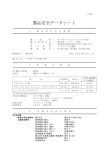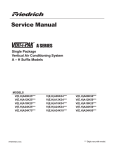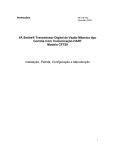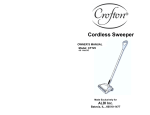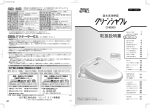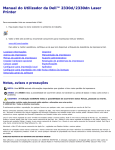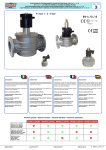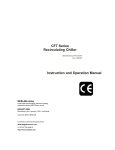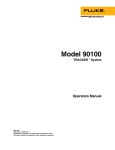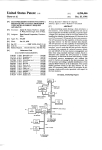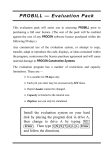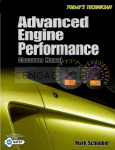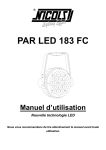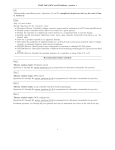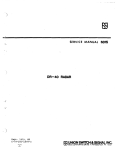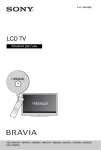Download NESLAB - Chiller City
Transcript
NESLAB CFT series using TC-200 controller NESLAB Manual P/N U00320 Rev. 22 June 1999 Service manual NESLAB online Product Service Information, Electronic Catalog, Applications Notes, MSDS Forms, e-mail. Call our bulletin board system (603)427-2490 Contact us for free FirstClass® access software. Specify Macintosh or Windows. Voice Info: (800) 4-NESLAB Visit our Web page at: http://www.neslabinc.com service resources NESLAB ONLINE NESLAB ONLINE is your source for online service data, including service bulletins, manuals, refrigerant charging information, calibration instructions, and more for all catalog units. You can browse the same library our Technical Support representatives use - and this is available 24 hours a day, 7 days a week. Obtain the access software, FirstClass Client, from sources on the next page or from us. Then use it to connect to (603) 4272490 by modem. FirstClass Client for FirstClass Client for 3 . x '9 5 NESLAB OFFLINE NESLAB OFFLINE is a cd-rom which contains all the content of NESLAB ONLINE as of Jan. 1 1998. This is ideal if you have no modem capability. The cd-rom works on both Macintosh and Windows computers. It also includes FirstClass Client. NESLAB OFFLINE cd-rom The EVAPORATOR The EVAPORATOR is our service newsletter. It contains service bulletins and information of interest to anyone who maintains NESLAB equipment. Name mail: NESLAB ONLINE PO Box 1178 Portsmouth NH 03802-1178 Company Address fax: (603) 430-6387 City e-mail: [email protected] State / Province Zip / Postal code e-mail address (optional) subscription to The Evaporator Sources for FirstClass Client for Macintosh Sources for FirstClass Client for Windows 3.5" disk: 3.5" disk: Obtain from NESLAB. The Mac client is published on red disks. If you have a CD drive, use one of the CD sources below as they carry a later version. Installation is not required - you can run the application right off the floppy disk. Obtain from NESLAB. The Windows client is published on blue disks. It works on Windows 3.x or Windows 95. If you have a CD-ROM drive, use the CD-ROM (below) instead as it carries a later version. CD-ROM: CD-ROM: NESLAB OFFLINE 1998 cd-rom NESLAB OFFLINE 1998 cd-rom cd-rom companion to the magazine: MacAddict, Issue #1, Sep. 1996 go to: Shareware / Connectivity / FirstClass Client. cd-rom companion to the magazine: MacAddict, Issue #13, Sep. 1997 go to: Shareware / Communications / FirstClass Client. cd-rom companion to the book: Macintosh Revelations by Ken Maki go to: Telecom / BBS Software / FirstClass Client. Any cd-rom shareware/software collection from BMUG (Berkeley Mac Users Group) N Download from NESLAB ONLINE: Download from NESLAB ONLINE: Go to Conferences / Software / Mac Go to Conferences / Software / Windows Download from America Online: Download from America Online: Keyword: SoftArc Keyword: Softarc Download from Compuserve: Download from Compuserve: TWEUROPA / Teletools / FCMAC.ZIP PCBBS / BBS programs / FCC300.EXE Download from World Wide Web: Download from World Wide Web: http: // www.softarc.com http: // www.softarc.com . . 4 Contents Section I: Safety Warnings ........................................................................................................................................................................ 6 Section II: General information After sale support ........................................................................................................................................................... 7 Other resources ............................................................................................................................................................. 7 Decoding part numbers ................................................................................................................................................. 8 Interface defined ............................................................................................................................................................ 9 Navigating loops ........................................................................................................................................................... 10 Operator’s loop ............................................................................................................................................................ 10 Setup loop .................................................................................................................................................................... 11 Calibration loop ............................................................................................................................................................ 13 Configuration loop ........................................................................................................................................................ 14 Service loop ................................................................................................................................................................. 15 Displaying software version ......................................................................................................................................... 16 Section III: Service Troubleshooting ........................................................................................................................................................... 17 Microprocessor replacement ....................................................................................................................................... 20 Error codes .................................................................................................................................................................. 21 Section IV: Adjustments Factory defaults ............................................................................................................................................................ Restoring factory defaults ............................................................................................................................................ Field calibration ............................................................................................................................................................ Hot gas valve ................................................................................................................................................................ 22 22 23 26 Service contracts ......................................................................................................................................................... Reservoir ...................................................................................................................................................................... Cleaning ....................................................................................................................................................................... Algae ............................................................................................................................................................................ Pump strainer ............................................................................................................................................................... Pump motor lubrication ................................................................................................................................................ Torque values ............................................................................................................................................................... 27 27 27 28 28 29 29 Refrigerant data ........................................................................................................................................................... MSDS form: R-134a refrigerant ................................................................................................................................... MSDS form: R-22 refrigerant ....................................................................................................................................... Service bulletin U00336: CFT75 - solenoid valve change ........................................................................................... Service bulletin U00349: CFT33 - check capacitor wiring ........................................................................................... Year 2000 statement .................................................................................................................................................... 30 31 33 38 39 40 Section V: Preventive maintenance Section VI: Reference 5 Section I: Safety Warnings Make sure you read and understand all instructions and safety precautions listed in this manual before installing or operating your unit. If you have any questions concerning the operation of your unit or the information in this manual, contact our Sales Department (see After-sale Support). Performance of installation, operation, or maintenance procedures other than those described in this manual may result in a hazardous situation and may void the manufacturer’s warranty. Observe all warning labels. Never remove warning labels. Never operate damaged or leaking equipment. Never operate the unit without cooling fluid in the reservoir. Always turn off the unit and disconnect the power source before performing any service or maintenance procedures, or before moving the unit. Always empty the reservoir before moving the unit. Never operate equipment with damaged line cords. Refer service and repairs to a qualified technician. In addition to the safety warnings listed above, warnings are posted throughout the manual. These warnings are designated by an exclamation mark inside an equilateral triangle with text highlighted in bold print. Read and follow these important instructions. Failure to observe these instructions can result in permanent damage to the unit, significant property damage, or personal injury or death. The lightning flash with arrow symbol, within an equilateral triangle, is intended to alert the user to the presence of non-insulated “dangerous voltage” within the unit’s enclosure. The voltage may be of significant magnitude to constitute a risk of electrical shock. 6 Section II: General information After Sale Support NESLAB is committed to customer service both during and after the sale. If you have questions concerning the operation of your unit, contact our Sales Department. If your unit fails to operate properly, or if you have questions concerning spare parts or service contracts, contact our Service Department. Before calling, please obtain the following information from the unit’s serial number label: part number serial number Other resources The Instruction and Operation Manual for the CFT series is PN U00362. Pump systems are covered in a separate service manual. For MD pumps, obtain service manual 000877. For PD pumps, obtain service manual 000878. 7 Decoding part numbers NESLAB identifies units using a 12-digit part number. To decode the part number, split up the digits as shown in the chart below. This will define what characteristics the unit has. 000 0 unit family condenser 128 EX111 129 EX211 130 EX221 131 EX411 132 EX511 134 RTE111 135 RTE211 136 RTE221 137 EX111 138 EX211 139 EX221 140 EX411 141 EX511 157 RTE140 167 RTE111 168 RTE211 169 RTE221 171 RTE140,LT50 331 CFT25A 332 CFT33A 333 CFT75A 334 CFT25, R12 335 CFT33, R12 336 CFT75, R12 337 CFT150,FAC200 347 CFT25, R22 348 CFT33, R22 349 CFT75, R22 386 HX75, R22 387 HX100, R22 388 HX150, R22 389 HX200, R22 390 HX300, R22 391 HX500, R22 392 HX750, R22 393 CFT25, R134a 394 CFT33, R134a 395 CFT75, R134a 396 CFT300,FAC400 397 CFT500 398 CFT750 400 CFT100 607 CFT50 608 CFT75 612 RTE microprocessor 613 CFT200 0 Not applicable 1 Air cooled 2 Water cooled 00 01 02 03 04 05 06 07 08 09 10 11 12 13 15 16 17 20 21 22 23 99 00 00 pump/head electrical 00 01 02 03 04 05 06 07 08 09 10 11 12 15 16 17 18 19 20 21 22 23 24 25 26 28 None 100v / 50Hz / 1ø 100v 60Hz (no longer used) 115v / 60Hz / 1ø 208-230v / 60Hz / 1ø 208-230v / 60Hz / 3ø 220-240v / 50Hz / 1ø 220-240v / 50Hz / 3ø Slave 440-480v / 60Hz / 3ø 380-415v / 50Hz / 3ø (4 wire) 100v / 50-60Hz 100-115v / 50-60Hz 200v / 50Hz / 1ø 200v / 50-60Hz Dual rated: 200v / 50Hz / 1ø 200-230v / 60Hz / 1ø 208v / 60Hz / 3ø (5 wire) 415v / 50Hz / 3ø 380-415v / 50Hz / 3ø (5 wire) 200-240v / 50-60Hz /1ø 380-480v / 50-60Hz / 3ø (4 wire) Special 29 30 31 99 8 No pump CP25 CP55 PD1 PD2 CP75 TU1 TU5 TU6 TU7 TU8 SS PD1 SS PD2 MD30 CP20 G1 F Pump, 1 Stage F Pump, 2 Stage Z Pump F Immersion head R Immersion head FV Immersion head H Pump Dual PD1 Dual PD2 was PD3, now unassigned CP100 TU9 TU3 Special 00 controller 01 02 03 04 05 06 07 08 09 10 11 12 13 14 15 16 17 Analog Digital, non bath Series II Programmable Basic Cryotrol Digital, bath UL approved UL approved plus interlocks UL approved plus alarm pkg. Microprocessor Digital remote (HX1000, HX2000) Fisher standard digital Controller I (TC100) Controller II (TC200) Controller III (TC300) Controller IV (TC400) 00 catalog Once upon a time 00 indicated a standard catalog unit, and 01 and up indicated the presence of customizing options and/or accessories. That distinction is no longer used and these digits have no special significance any more. Interface defined This statement defines NESLAB’s policy towards access and contents of various control loops for TC200, TC300, and TC400 controller applications. It is provided by the Measurement and Control group. With an increasing number of controller applications it is important to maintain consistency in the way we code our operator interface. The goal is to minimize the effort to code, build, test, document, use, and service our products. Unless the customer specification specifically requests a different approach, the operator interface will be programmed in the following manner. Private loops are those requiring a proprietary access code, as described in this manual. Operator’s loop (public): This is the default power-up loop. This loop is for basic display information and the location of the process setpoint adjustment, flow 1, flow 2, resistivity, etc. Setup/tune loop (public): This loop contains any other adjustments the customer is expected to access. Consider this an advanced user’s loop. If the customer is expected to change it, then it goes here. Example: Proportionalintegral-derivative (PID) values, alarm setpoints, communication enable and parameters, remote sensor enable, selection of °F or °C display, etc. Configuration loop (private): This loop is used by NESLAB production to enter any factory settings. These are not intended to be changed after the initial setting. Some designs may not have anything in the Configuration Loop. Example: injector setpoint and settings, high and low span, interlocks or cutouts, 50/60 Hz power selection, etc. Calibration loop (private): This loop allows the operator to calibrate temperature and other variables to reference instruments. Service loop (private): This is intended for service personnel to aid in field trouble-shooting. The service loop allows the controller inputs and outputs to be monitored and changed for testing of the electrical control system and components. Each application needs an unique one page service sheet that defines the controller inputs/outputs before the service loop can be used. Documentation: The operators manual will only contain the operator’s loop and setup/tune loop information. The appendix of the operators manual may also contain the calibration loop information. The service manual will contain all the different loops. Mark Sinclair Measurement and Control Manager 9 Navigating the loops hold OPERATOR’S LOOP NEXT SETUP LOOP TUNE XX C PUBLIC LOOPS PRIVATE LOOPS hold CALIBRATION LOOP hold CONFIGURATION LOOP CAL SERVICE LOOP CONF hold SERV Operator’s loop 10 Setup loop - part 1 11 Setup loop - part 2 12 Calibration loop 13 Configuration loop 14 Service loop 15 Displaying software version The TC-200 controller has a function which will show the installed software version number on the unit’s digital display. For example, for a unit with software version 000550.45B: 1. Unit is running normally and displaying temperature. 2. Press and hold the NO key for at least 10 seconds. The display will show the digits to the left of the decimal (for example): 0550 (note the two leading zeros are not shown). 3. Press the NEXT key. The display will show the digits to the right of the decimal (for example): 45 4. Press the NEXT key. The display will show the revision letter, as its equivalent number, with A=1, B=2, etc. (for example): 2 5. Press the NEXT key. The digits shown may be disregarded. 6. Press the NEXT key. The display returns to normal, displaying temperature. 16 Section III. Service Troubleshooting Unit will not start Check the line cord, make sure it is plugged in. Check the voltage of the power source. Make sure it is within the rated voltage of the unit, ±10%. Check that the Power Switch/Circuit Breaker has not tripped. Check the setting on the optional High Temperature Cutout. CFT-300 units are equipped with high and low pressure switches. If either switch activates the unit will shut down. Once the cause has been determined you have to manually reset the switch. The switches are located behind the rear panel, see the operation manual. Unit will not circulate fluid Check the reservoir level. Fill, if necessary. Make sure the pump has been purged. Check the pressure gauge (units with PD pumps). If the reading is 60 psig, check the instrument being cooled for restrictions in the cooling line. Check the pump strainer (units with PD pumps). A clogged strainer can starve the pump. Inadequate temperature control If the temperature continues to rise, make sure the heat load of the instrument being cooled does not exceed the rated specification, see the operating manual for specifications. Make sure the air intake and discharge are not impeded and the ambient temperature does not exceed +35°C. Make sure the condenser is free of dust and debris. If the compressor short-cycles (a clicking sound), check the line voltage. It should be within the 10% of the specified voltage. Wait 5 minutes before restarting the unit. 17 Symptom Possible cause Repair Compressor will not start - no hum 1. Line disconnect switch open 2. Line fuse (if any) removed or blown 3. Overload protector tripped 4. Wiring improper or loose 1. Close start or disconnect switch 2. Replace fuse 3. Allow compressor to cool 4. Check against wiring diagram Compressor will not start - hums but trips on overload protector 1. Improperly wired 2. Low line voltage 3. Start capacitor defective 4. Relay failing to close 5. Compressor motor has winding open or shorted 6. Compressor mechanical failure 7. Liquid refrigerant in compressor 1. Check against wiring diagram 2. Determine reason and correct 3. Determine reason and replace 4. Determine reason and correct, replace if necessary 5. Replace compressor 6. Replace compressor 7. Add crankcase heater and/or accumulator 1. Improperly wired 2. Low line voltage 3. Relay failing to open 1. Check against wiring diagram 2. Determine reason and correct 3. Determine reason and correct, replace if necessary 4. Determine reason and replace 5. Check discharge shut-off valve, possible overcharge, or insufficient cooling on condenser 6. Replace compressor 7. Replace compressor Compressor starts, but does not switch off start winding 4. Run capacitor defective 5. Excessive discharge pressure 6. Compressor motor has winding open or shorted 7. Compressor mechanical failure 8. Compressor motor has a winding shorted 1. Check wiring diagram. Check for added fan motors, pumps, etc., connected to wrong side of protector 2. Determine reason and correct. 3. Check current, replace protector 4. Determine reason and replace 5. Check ventilation, restrictions in recirculating fluid path, restrictions in refrigeration system 6. Check for possibility of misapplication. Use stronger unit 7. Check refrigerant charge (fix leak), add if necessary 8. Replace compressor 1. Overload protector 2. High temperature cutout, if so equipped 1. See entire section above 2. Heat load too high, fluid flow too low 3. High pressure cutout due to: a. insufficient air or water supply b. overcharge c. air in system 3a. Check air or water supply to condenser 3b. Reduce refrigerant charge 3c. Purge 1. Additional current passing through overload protector Compressor starts and runs, but short cycles on overload protector 2. Low line voltage, or unbalanced if three-phase 3. Overload protector defective 4. Run capacitor defective 5. Excessive discharge pressure 6. Suction pressure too high 7. Compressor too hot, return gas hot Unit runs but continually stops and restarts 4. Low pressure cutout due to: a. liquid line solenoid leaking b. compressor valve leak c. undercharge d. restriction in expansion device 18 4a. Replace 4b. Replace 4c. Fix leak, add refrigerant 4d. Replace device Symptom Possible cause Repair Unit operates long or continuously 1. Shortage of refrigerant 2. Control contacts stuck closed 3. Refrigerated fluid has excessive load or poor insulation 4. System inadequate to handle load 5. Evaporator coil iced 6. Restriction in refrigeration system 7. Dirty condenser 8. Air filter (if any) dirty 1. Fix leak, add charge 2. Clean contacts or replace 3. Determine fault and correct 4. Replace with larger system 5. Defrost 6. Determine location and remove 7. Clean condenser 8. Clean on replace Start capacitor open, shorted, or blown 1. Relay contacts not operating properly 2. Prolonged operation on start cycle due to: a. low voltage to unit b. improper relay c. starting load too high 3. Excessive short cycling 4. Improper capacitor 1. Clean contacts, replace relay if needed 2a. Determine reason and correct 2b. Replace 2c. Correct 3. Determine reason and correct 4. Determine correct size and replace Run capacitor open, shorted, or blown 1. Improper capacitor 2. Excessively high line voltage (110% of rated maximum) 1. Determine correct size and replace 2. Determine reason and correct Relay defective or burned out 1. Incorrect relay 2. Incorrect mounting angle 3. Line voltage too high or too low 4. Excessive short cycling 5. Relay being influenced by loose vibrating mounting 6. Incorrect run capacitor 1. Check and replace 2. Remount relay in correct position 3. Determine reason and correct 4. Determine reason and correct 5. Remount rigidly 6. Replace with proper capacitor Recirculating fluid temperature too high 1. Control setpoint too high 2. Expansion valve too small 3. Evaporator too small 4. Inadequate air circulation through condenser 1. Reset setpoint. 2. Use larger valve. 3. Add surface area or replace 4. Improve air movement Suction line frosted or sweating 1. Expansion valve passing excess refrigerant or is oversized 2. Expansion valve stuck open 3. Overcharge of refrigerant 1. Readjust valve or replace with smaller valve 2. Clean valve of foreign particles, replace if necessary 3. Correct charge Liquid line frosted or sweating 1. Restriction in drier or strainer 2. Liquid shut off (king valve) (if so equipped) partially closed 1. Replace part 2. Open valve fully Unit noisy 1. Loose parts or mountings 2. Tubing rattle 3. Bent fan blade causing vibration 4. Fan motor bearings worn 1. Find and tighten 2. Reform to be free of contact 3. Replace blade 4. Replace motor 19 Microprocessor replacement 1. WARNING: Physically disconnect unit from line voltage. 2. Use proper Electro-Static Discharge (ESD) protection procedures. A wrist strap is mandatory, at a minimum. NESLAB is not responsible for replacement of integrated circuits damaged by ESD. 3. A Plastic Leaded Chip Carrier (PLCC) extraction tool is required. 4. Remove wrapper of unit. 5. Remove the cover from the control box. On CFT-25, 33, and 75 there are four screws. On CFT-150 and larger, there are only two screws. 6. CFT-25, 33, and 75 only: The control box assembly must be pulled outside the case to allow access room. Remove the two nuts that hold the control box assembly to the case. Tip the control box assembly out of the hole in the case. Remove the secondary cover (the one with all the strain reliefs mounted to it). Note: On CFT-150 and larger, there is adequate access room. The control box assembly may remain mounted to the case. 7. Observe the pin orientation of the old microprocessor chip. Remove it using the PLCC extraction tool. Install the new microprocessor chip, making sure the pin 1 designation on the microprocessor chip (a dimple in the middle of one side) and the socket (generally a triangle pointer on the socket or the circuit board) align. DO NOT USE THE ORIENTATION OF THE PAPER LABEL FOR ALIGNMENT. THE PAPER LABEL ORIENTATION IS ARBITRARY. arrow slots for extraction tool dot empty socket chip chip in socket 8. Reassemble the unit and all covers. 9. Plug unit in and turn it on. Error messages will appear. Press ENTER/NEXT after each error message until the temperature display appears. 10. The unit is now operational, but calibration has been lost. Calibrate unit per instructions in this manual. 20 Error codes On power up: These messages will be displayed on the controller. The controller will wait for someone to press the next/enter key. Once the “next/enter” key is pressed the controller will restore factory defaults and begin to run. For example if “Err1” is on the controller display at power up, this indicates the internal ram is messed up. Er01 - Ram test failure Er02 - Keypad failure, shorted keypad Er03 - Critical checksum failure, will restore all factory defaults. Er04- Non-Critical checksum failure, will restore 1/2 of factory values, keeps calibration, PID, restore setpoint Unusual Hardware Conditions These errors will flash on the display and cannot be cleared. These are internal controller problems. Er04 thru Er15 - Interrupt errors during runtime Functional/ Machine errors These are the runtime/ logic errors these errors will clear themselves once the problem disappears. Er16 - Bad calibration data - recalibrate controller Er19 - Low temperature alarm Er21 - High temperature alarm Er22 - High tank temperature Er23 - Shorted RTD2 Er24 - Open RTD2 Er25 - Shorted RTD1 Er26 - Open RTD1 Er31 - Low level fault ADD - Low level alarm 21 Section IV. Adjustments Factory defaults Cool PID values: Pro 20 Int 0.5 Der 0 Heat PID values: Pro 5 Int 0.5 Der 0 Alarms Hi temp Lo temp 90 -20 Span CFT25/33/75 standard temp CFT25/33/75 high temp CFT25/33/75 low temp CFT150/300 standard temp CFT150/300 high temp CFT150/300 low temp Lo limit 5 Lo limit 5 Lo limit -15 Hi limit 30 Hi limit 85 Hi limit 30 Lo limit 5 Lo limit 5 Lo limit -15 Hi limit 35 Hi limit 85 Hi limit 35 Cool cycle 15 Restoring factory defaults This procedure will restore all controller values to the factory default settings (which vary by product). 1. Begin in the Operator’s loop, displaying temperature as normal. 2. Hold NO, and while holding it, press YES, YES, YES. This should result in the Calibration Loop, with the display indicating “CaL”. 3. Hold NO, and while holding it, press YES, YES, YES. This should result in the Configuration Loop, with the display indicating “ConF”. 4. Hold NO, and then press and hold NEXT/ENTER for seven seconds minimum. This should result in the display indicating “reSt” (meaning RESTORE). 5. Press YES. The controller will restore the factory default settings and return to the Operator’s Loop. 22 Field calibration The unit is calibrated at the factory. Changing any values will nullify temperature indications. The calibration loop should only be used by qualified factory or service personnel. Improper calibration can affect product temperature measurements. Requirements Temperature calibration is performed at two different temperatures. Calibration will be valid at and between those temperatures. The unit must run at both of these temperatures in turn to be calibrated. A reference thermometer is required. Choosing calibration points Decide what two temperatures you wish to use as calibration points. The temperatures chosen must be within the operating range of the unit (5° - 30°C), achievable, and measurable using a reference thermometer. Calibration will be most valid when the two points are as separated as possible, i.e. 5°C and 30°C. If the unit is only operated at one temperature (for example, 22°C), you may wish to optimize calibration at that point by choosing closer calibration points; such as 20° and 24°C. Procedure - overview The general procedure consists of: 1. From operator’s loop, adjust setpoint to lower calibration point 2. Allow unit to achieve the lower calibration point. 3. Go to calibration loop, enter the reference thermometer value. 4. Go to operator’s loop, adjust setpoint to higher calibration point 5. Allow unit to achieve the higher calibration point. 6. Go to calibration loop, enter the reference thermometer value. Note: The calibration points are independent. The higher point may be set first if more convenient. The step-by-step procedure follows. 23 Begin in the Operator’s Loop Immerse a reference thermometer in the circulating fluid. XXXC Display current temperature. NEXT SP XXXC XXXC Controller is ready to receive a new setpoint. This will become the lower calibration point. NEXT Use YES/NO keys to increment digits to the lower calibration point. Unit now begins to go to the lower calibration point. Use private key to go to the Calibration Loop. hold CAL RTD1 Decline higher calibration point R1H Accept lower calibration point R1L RTD2 STOR R1L XXXC NEXT Decline RTD2 calibration Save changes Return to Operator’s Loop XXXC go to next page 24 Use YES/NO keys to increment digits to the temperature shown on the reference thermometer. from previous page Ensure the reference thermometer is immersed in the circulating fluid. XXXC Display current temperature. NEXT SP XXXC XXXC Controller is ready to receive a new setpoint. This will become the higher calibration point. NEXT Use YES/NO keys to increment digits to the higher calibration point. Unit now begins to go to the higher calibration point. Use private key to go to the Calibration Loop. hold CAL RTD1 Accept higher calibration point R1H R1H R1L XXXC NEXT Decline lower calibration point RTD2 Decline RTD2 calibration STOR Save changes Return to Operator’s Loop XXXC calibration is complete 25 Use YES/NO keys to increment digits to the temperature shown on the reference thermometer. Hot gas valve The hot gas valve is adjusted as follows. WARNING: Disconnect unit from line voltage. 1. Attach refrigerant gauges and verify that the refrigerant charge is approximately correct. 2. Start unit and allow it to stabilize. 3. Turn unit setpoint up so unit remains in the heat/idle cycle. 4. Observe suction pressure gauge. 5. Compare reading of gauge to that in the refrigerant data table. 6. Adjust valve, if necessary, to comform to the table. 7. Turn unit off. WARNING: Disconnect unit from line voltage. 8. Remove refrigerant gauges. 26 Section V. Preventive maintenance For personal safety and equipment reliability, the following procedure should only be performed by a qualified technician. Contact our Service Department for assistance (see After-sale Support). Service contracts NESLAB offers on-site Service Contracts that are designed to provide extended life and minimal down-time for your unit. For more information, contact our Service Department (see After-sale Support). Draining the reservoir The CFT-300 is equipped with a ½ inch FPT DRAIN fitting located on the rear of the unit. To drain the CFT-25 to CFT-150 reservoirs we recommend the use of a wet/dry vacuum. Remove the reservoir plug and carefully insert the wet/dry vacuum so as not to damage the cooling coils. NOTE: Tilting the unit more than 45° may allow compressor oil to seep into the suction line. Cleaning Reservoir Periodically inspect the fluid inside the reservoir. If cleaning is necessary, flush the reservoir with a cleaning fluid compatible with the circulating system and the cooling fluid. The cooling fluid should be replaced periodically. When operating at low temperatures, the concentration of water in the cooling fluid will increase over time, leading to a loss of cooling capacity. Before changing the cooling fluid, raise the operating temperature of the unit to de-ice the cooling coils. Refer to the operating manual for instructions on replacing the cooling fluid. Condenser For proper operation, the unit needs to pull substantial amounts of air through a condenser. A build up of dust or debris on the fins of the condenser will lead to a loss of cooling capacity. The lower front of the unit has a one-piece grille assembly. Gently pry the assembly off with a flathead screwdriver. Use care not to scratch the paint. Periodic vacuuming of the condenser fins is necessary. The frequency of cleaning depends on the operating environment. We recommend a visual inspection of the condenser be made monthly after initial installation. After several months, the frequency of cleaning will be established. 27 Algae To restrict the growth of algae in the reservoir, it is recommended that the reservoir cover be kept in place and that all circulation lines be opaque. This will eliminate the entrance of light which is required for the growth of most common algae. NESLAB recommends the use of Chloramine-T, 1 gram per 3.5 liters. Pump strainer Units with PD pumps have a strainer. Refer to the pump label on the rear of the unit to identify the type of pump in your unit. If debris is in the system, the strainer will prevent the material from being drawn into the pump and damaging the pump vanes. After initial installation, the strainer may become clogged with debris and scale. Therefore, the strainer must be cleaned after the first week of installation. After this first cleaning, a monthly visual inspection is recommended. After several months, the frequency of cleaning will be established. Before cleaning the strainer, disconnect the power cord from the power source and drain the reservoir. PD-1 pumps have a wire mesh strainer located in the pump head. PD-2 pumps have the strainer located in the pump suction line. Remove the wrapper from the unit. Unscrew the larger of the two acorn nuts on the pump head and remove the screen. Clean the screen by rinsing it with water. When the screen is clean, replace it in the strainer, tighten the acorn nut and replace the wrapper. Refer to the operating manual for instructions on replacing the cooling fluid. PD-2 Strainer PD-1 Strainer 28 Pump motor lubrication PD pump motors require periodic lubrication. Refer to the pump label on the rear of the unit to identify the type of pump in your unit. PD pumps use sleeve type bearings with large reservoirs. Oiling instructions are generally posted on each motor. In the absence of instructions, add approximately 30 to 35 drops of SAE 20 non-detergent oil to each bearing on the following schedule (SAE 20 = 142 CS viscosity): Duty Cycle Oiling Frequency Continuous Once every year Intermittent Once every 2 years Occasional Once every 5 years Fill Holes (Typical) Torque V-band clamp The V-band clamp (which joins the pump to the motor) should be tightened to 15 - 30 inch-pounds (85 - 170 cm/kg) of torque. Hose clamps The unit's internal and external hoses and clamps should be inspected and tightened on at least a semiannual basis. If the unit uses standard clear reinforced hose (with the reinforcement webbing visible in the wall of the hose), tighten hose clamps to 50 in/lbs (280 cm/kg). Note that this type hose will cold-flow, so the clamps will need to retorqued later after the hose conforms to the clamps. (Be aware the hose clamps do not actually loosen, but rather the hose O.D. decreases under them!) It is best to give them a final torqueing just prior to leaving the job site. It is wise to explain to the customer that a further torqueing may be required the following day - and that a drip developing at the hose clamp is a result of this cold-flow and not poor workmanship. 29 Section VI. Reference refrigerant data Model CFT-25 CFT-33 CFT-75 CFT-150 CFT-300 CFT-300 Pump any any any any CP55,TU5,TU6 PD2 R-134a R-134a R-134a R-22 R-22 R22 Amount 4 oz 7 oz 13.75 oz 29 oz 8.5-9.5 lbs 8.5-9.5 lbs Amount (metric) 115 g 200 g 390 g 822 g 3.8-4.3 kg 3.8-4.3 kg Hot gas setting (PSIG) 5 5 5 25 25 25 Hot gas setting (kPa) 35 35 35 172 172 172 Ambient (°F) 68 68 68 68 74 74 Fluid temp (°C) 20 20 20 20 20 20 25-28 42-45 37-41 70 85-90 88-94 Suction pressure (kPa) 172-193 290-310 255-282 480 585-620 605-650 Discharge pressure (PSIG) 145-160 180-200 170-185 270 265-280 265-280 1000-1100 1240-1380 1175-1275 1860 1827-1930 1827-1930 4.0 2.5 4.6 2.8 6.4 6.4 Refrigerant Suction pressure (PSIG) Discharge pressure (kPa) Speed check (°C/min) 6024 30 material safety data sheet (MSDS) A Material Safety Data Sheet (MSDS) is designed to provide both workers and emergency personnel with the proper procedures for handling or working with that substance. MSDS will include information such as physical data (melting point, boiling point, flash point etc.), toxicity, health effects, first aid, reactivity, storage, disposal, protective equipment, and spill/leak procedures. These are of particular use if a spill or other accident occurs. This Material Safety Data Sheets is provided as a public service. It was gathered from a variety of sources. Neither NESLAB Instruments, Inc., nor any of its agents are liable for the accuracy, or inaccuracy, of the Material Safety Data Sheet. You assume the liability for the use of any part of this Material Safety Data Sheet. R-134a refrigerant DUPONT E I — SUVA COLD-MP, SUVA 134A MATERIAL SAFETY DATA SHEET FSC: 6830 NIIN: 00D003276 Manufacturer’s CAGE: 02348 Part No. Indicator: A Part Number/Trade Name: SUVA COLD-MP, SUVA 134A =========================================================================== General Information =========================================================================== Company’s Name: DU PONT E I DE NEMOURS & CO Company’s Street: 1007 MARKET ST Company’s City: WILMINGTON Company’s State: DE Company’s Country: US Company’s Zip Code: 19899 Company’s Emerg Ph #: 800-441-7515/800-441-3637 Company’s Info Ph #: 800-441-7515 Record No. For Safety Entry: 001 Tot Safety Entries This Stk#: 001 Status: SE Date MSDS Prepared: 12MAR94 Safety Data Review Date: 14JUL94 Supply Item Manager: CX MSDS Preparer’s Name: ENGIN. & PRODUCT SAFETY Preparer’s Company: DUPONT CHEMICALS Preparer’s St Or P. O. Box: POB 80709, CHESTNUT RUN Preparer’s City: WILMINGTON Preparer’s State: DE Preparer’s Zip Code: 19880-0709 MSDS Serial Number: BTRLM Specification Number: NOT KNOWN Hazard Characteristic Code: G3 Unit Of Issue: UK Unit Of Issue Container Qty: UNKNOWN Type Of Container: UNKNOWN Net Unit Weight: UNKNOWN =========================================================================== Ingredients/Identity Information =========================================================================== Proprietary: NO Ingredient: 1,1,1,2-TETRAFLUOROETHANE Ingredient Sequence Number: 01 Percent: 100 NIOSH (RTECS) Number: 1008365TE CAS Number: 811-97-2 OSHA PEL: NOT ESTABLISHED ACGIH TLV: NOT ESTABLISHED Other Recommended Limit: NONE RECOMMENDED =========================================================================== Physical/Chemical Characteristics =========================================================================== Appearance And Odor: LIQUEFIED GAS, SLIGHT ETHEREAL ODOR, COLORLESS. Boiling Point: -16F,-27C Melting Point: N/A Vapor Pressure (MM Hg/70 F): 96PSIA@25C Vapor Density (Air=1): 3.60 @25C Specific Gravity: N/A Decomposition Temperature: N/A Solubility In Water: 0.15WT% @25C/14.7PSI Percent Volatiles By Volume: 100 pH: N/A =========================================================================== Fire and Explosion Hazard Data =========================================================================== Flash Point: WILL NOT BURN 31 Lower Explosive Limit: N/A Upper Explosive Limit: N/A Extinguishing Media: AS APPROPRIATE FOR COMBUSTIBLES IN AREA. Special Fire Fighting Proc: COOL CYLINDERS W/WATER SPRAY. SELF-CONTAINED BREATHING APPARATUS MAY BE REQUIRED IF CYLINDERS RUPTURE OR RELEASE UNDER FIRE CONDITIONS. Unusual Fire And Expl Hazrds: CYLINDERS MAY RUPTURE UNDER FIRE CONDITONS. DECOMPO MAY OCCUR.EXPERIMENTAL DATA HAVE REPORTED COMBUST OF MATL IN PRESENCE OF CERTAIN CONCEN OF CHLORINE.SEE SUPPL =========================================================================== Reactivity Data =========================================================================== Stability: YES Cond To Avoid (Stability): AVOID OPEN FLAMES AND HIGH TEMPERATURE. ALSO GLOWING METAL SURFACES. Materials To Avoid: ALKALI OR ALKALINE EARTH METALS-POWDERED ALUMINUM, ZINC, BERYLIUM, ETC. CERTAIN CONCENTRATIONS OF CHLORINE. Hazardous Decomp Products: DECOMPOSES @ HI TEMP FORMING HYDROFLUORIC ACID AND POSSIBLY CARBONYL FLUORIDE. Hazardous Poly Occur: NO Conditions To Avoid (Poly): NOT RELEVANT. =========================================================================== Health Hazard Data =========================================================================== LD50-LC50 Mixture: DUPONT’S 1000PPM, 8 & 12 HR TWA. Route Of Entry - Inhalation: YES Route Of Entry - Skin: YES Route Of Entry - Ingestion: NO Health Haz Acute And Chronic: INHAL OF HI CONCEN OF VAPOR IS HARMFUL & MAY CAUSE HEART IRREGULARITIES, UNCONSCIOUSNESS OR DEATH. VAPOR REDUCES OXYGEN AVAILABLE FOR BREATHING & IS HEAVIER THAN AIR. LIQ CONTACT CAN CAUSE FROSTBITE. Carcinogenicity - NTP: NO Carcinogenicity - IARC: NO Carcinogenicity - OSHA: NO Explanation Carcinogenicity: PER MSDS:NONE OF COMPONENTS PRESENT IN MATL @ CONCEN = OR < 0.1% ARE LISTED BY IARC,NTP, OSHA OR ACGIH AS A CARCINOGEN. Signs/Symptoms Of Overexp: OVEREXOSURE BY INHAL TO VERY HI CONCEN MAY CAUSE TEMP ALTERATION OF THE HEART’S ELECTRICAL ACTIVITY WITH IRREGULAR PULSE, PALPITATIONS, OR INADEQUATE CIRCULATION. SKIN CONTACT WITH THE LIQUID MAY CAUSE FROSTBITE. Med Cond Aggravated By Exp: INDIVIDUALS WITH PRE-EXISTING DISEASES OF THE CENTRAL NERVOUS OR CARDIOVASCULAR SYSTEM MAY HAVE INCREASED SUSCEPTIBILITY TO THE TOXICITY OF EXCESSIVE EXPOSURES. Emergency/First Aid Proc: INHAL:IMMED REMOVE TO FRESH AIR.KEEP PERSON CALM.NOT BREATH GIVE ARTIF RESP.BREATH DIFFI GIVE OXY.CALL DR. SKIN:IMMED FLUSH W/LOTS OF H2O FOR @ LEAST 15MINS.REMOVE CONTAM CLOTH/SHOE.CALL DR. TREAT FOR FROSTBITE IF NECESSARY BY GENTLY WARMING AFFECTED AREA.EYE:IMMED FLUSH W/LOTS OF H2O FOR @ LEAST 15MINS.CALL DR. DR:BECAUSE POSSIBLE DISTRUBANCES OF CARDIAC RHYTHM USE CATECHOLAMINE DRUGS CAUTIOUSLY. =========================================================================== Precautions for Safe Handling and Use =========================================================================== Steps If Matl Released/Spill: REVIEW FIRE FIGHTING MEASURES BEFORE PROCEEDING W/CLEANUP.USE APPROPRIATE PPE DURING CLEANUP.VENTI AREAESPECIALLY LOW OR ENCLOSED PLACES WHERE HEAVY VAPORS COLLECT.REMOVE OPEN FLAMES.USE SCBA IF LG SPILL OR LEAK OCCURS. Neutralizing Agent: NOT SPECIFIED BY MANUFACTURER. Waste Disposal Method: CONTAMINATED HFC-134A CAN BE RECOVERED BY DISTILLATION OR REMOVED TO A PERMITTED WASTE DISPOSAL FACILITY. COMPLY WITH LOCAL, STATE AND FEDERAL REGULATIONS. Precautions-Handling/Storing: STORE IN CLEAN, DRY AREA. DO NOT HEAT ABOVE 52C. USE W/SUFFICIENT VENTILATION TO KEEP EMPLOYEE EXPOSURE BELOW RECOMMENDED LIMITS. Other Precautions: HFC-134A SHOULD NOT BE MIXED W/AIR FOR LEAK TESTING OR USEDS W/AIR FOR ANY OTHER PURPOSE ABOVE ATMOSPHERIC PRESSURE. SEE FIRE & EXPLOSION DATA & SUPPLEMENTAL SECS. CONTACT W/CHLORINE OR OTHER STRONG OXIDIZING AGENTS SHOULD ALSO BE AVOIDED. =========================================================================== Control Measures =========================================================================== Respiratory Protection: UNDER NORMAL MANUFACTURING CONDITIONS NO RESPIRATORY PROTECTION IS REQUIRED WHEN USING THIS PRODUCT. SELF-CONTAINED BREATHING APPARATUS (SCBA) IS REQUIRED IF A LARGE RELEASE OCCURS. Ventilation: NORMAL VENTILATION FOR STANDARD MANUFACTURING PROCEDURES IS GENERALLY ADEQUATE. Protective Gloves: IMPERVIOUS GLOVES. Eye Protection: CHEM SPLASH GOGGLES. Other Protective Equipment: NONE SPECIFIED BY MANUFACTURER. Work Hygienic Practices: WASH CONTAMINATED CLOTHING/SHOE PRIOR TO REUSE. Suppl. Safety & Health Data: MATL NOT FLAMM @ AMBIENT TEMP & ATM 32 PRESSURE.TESTS HAVE SHOWN COMBUSTIBLE @ PRESSURE AS LOW AS 5.5 PSIG @ 177C WHEN MIXED W/AIR @ CONCEN OF GENERALLY MORE THAN 60 VOLUME % AIR.AT LOWER TEMP,HIGHER PRESSURE ARE REQUIRED FOR COMBUSTIBILITY. DO NOT USE IN MED APPLICATINS INVOLVING PERMANENT IMPLANTATION IN THE HUMAN BODY. =========================================================================== Transportation Data =========================================================================== Trans Data Review Date: 94195 DOT PSN Code: DQQ DOT Proper Shipping Name: COMPRESSED GASES, N.O.S. * DOT Class: 2.2 DOT ID Number: UN1956 DOT Label: NONFLAMMABLE GAS IMO PSN Code: EQH IMO Proper Shipping Name: COMPRESSED GAS, N.O.S. * IMO Regulations Page Number: 2125 IMO UN Number: 1956 IMO UN Class: 2(2.2) IMO Subsidiary Risk Label: IATA PSN Code: HDO IATA UN ID Number: 1956 IATA Proper Shipping Name: COMPRESSED GAS, N.O.S. * * IATA UN Class: 2.2 IATA Label: NON-FLAMMABLE GAS AFI PSN Code: HDO AFI Prop. Shipping Name: COMPRESSED GAS, N.O.S. AFI Class: 2.2 AFI ID Number: UN1956 AFI Label: NON-FLAMMABLE GAS AFI Basic Pac Ref: 6-6,6-8,6-10 N.O.S. Shipping Name: COMPRESSED OR LIQUIFIED GAS, N.O.S (TETRAFLUOROETHANE). R-22 refrigerant E I DUPONT — FREON 22 - MONOCHLORODIFLUOROM MATERIAL SAFETY DATA SHEET NSN: 6830013825105 Manufacturer’s CAGE: 18873 Part No. Indicator: A Part Number/Trade Name: FREON 22 =========================================================================== General Information =========================================================================== Item Name: MONOCHLORODIFLUOROM Company’s Name: E I DUPONT DE NEMOURS & CO Company’s Street: 1007 MARKET ST Company’s City: WILMINGTON Company’s State: DE Company’s Country: US Company’s Zip Code: 19898 Company’s Emerg Ph #: 800-441-3637;800-424-9300(CHEMTREC) Company’s Info Ph #: 800-441-9442 Record No. For Safety Entry: 001 Tot Safety Entries This Stk#: 003 Status: SMJ Date MSDS Prepared: 13AUG92 Safety Data Review Date: 15MAR95 MSDS Serial Number: BXBSX =========================================================================== Ingredients/Identity Information =========================================================================== Proprietary: NO Ingredient: METHANE, CHLORODIFLUORO-; (CHLORODIFLUOROMETHANE) (SARA 313) (CERCLA) Ingredient Sequence Number: 01 Percent: 100 NIOSH (RTECS) Number: PA6390000 CAS Number: 75-45-6 OSHA PEL: 1000 PPM ACGIH TLV: 1000 PPM ——————————————————Proprietary: NO Ingredient: SUP DAT: IN THE PRESENCE OF CERTAIN CONCENTRATIONS OF CHLORINE. Ingredient Sequence Number: 02 NIOSH (RTECS) Number: 9999999ZZ OSHA PEL: NOT APPLICABLE ACGIH TLV: NOT APPLICABLE 33 ——————————————————Proprietary: NO Ingredient: VENT: VENTILATION SHOULD BE USED IN LOW OR ENCLOSED PLACES. Ingredient Sequence Number: 03 NIOSH (RTECS) Number: 9999999ZZ OSHA PEL: NOT APPLICABLE ACGIH TLV: NOT APPLICABLE ——————————————————Proprietary: NO Ingredient: OTHER PREC: “FREON 22” SHOULD NOT BE MIXED W/AIR FOR LEAK TESTING. IN GEN, IT SHOULD NOT BE USED/ALLOWED TO BE (ING 5) Ingredient Sequence Number: 04 NIOSH (RTECS) Number: 9999999ZZ OSHA PEL: NOT APPLICABLE ACGIH TLV: NOT APPLICABLE ——————————————————Proprietary: NO Ingredient: ING 4: PRESENT W/HIGH CONCS OF AIR ABOVE ATMOSPHERIC PRESS. CONT W/CHLORINE/OTHER STRONG OXIDIZING AGENTS SHOULD (ING 6) Ingredient Sequence Number: 05 NIOSH (RTECS) Number: 9999999ZZ OSHA PEL: NOT APPLICABLE ACGIH TLV: NOT APPLICABLE ——————————————————Proprietary: NO Ingredient: ING 5: ALSO BE AVOIDED. Ingredient Sequence Number: 06 NIOSH (RTECS) Number: 9999999ZZ OSHA PEL: NOT APPLICABLE ACGIH TLV: NOT APPLICABLE ——————————————————Proprietary: NO Ingredient: EFTS OF OVEREXP: OVEREXP. SKIN CONT W/LIQUID MAY CAUSE FRSTBT. INDIVIDUALS W/PREEXISTING DISEASES OF CNS OR (ING 8) Ingredient Sequence Number: 07 NIOSH (RTECS) Number: 9999999ZZ OSHA PEL: NOT APPLICABLE ACGIH TLV: NOT APPLICABLE ——————————————————Proprietary: NO Ingredient: ING 7: CARDIOVASCULAR SYSTEM MAY HAVE INCREASED SUSCEPTIBILITY TO TOXICITY OF EXCESSIVE EXPOSURES. Ingredient Sequence Number: 08 NIOSH (RTECS) Number: 9999999ZZ OSHA PEL: NOT APPLICABLE ACGIH TLV: NOT APPLICABLE Other Recommended Limit: YN/KNONE RECOMMENDED ——————————————————Proprietary: NO Ingredient: HLTH HAZ: RANGING FROM 5% TO 70% INCLUDE EFTS ON CNS, LIVER, LUNGS, KIDNEYS, SPLEEN; CARDIAC SENSIT; DECREASED (ING 10) Ingredient Sequence Number: 09 NIOSH (RTECS) Number: 9999999ZZ OSHA PEL: NOT APPLICABLE ACGIH TLV: NOT APPLICABLE ——————————————————Proprietary: NO Ingredient: ING 9: BODY WT GAIN, & PARTIAL ANESTH. IN CHRONIC INHAL STUDIES FC-22 PRODUCED A SM, BUT STATISTICALLY (ING 11) Ingredient Sequence Number: 10 NIOSH (RTECS) Number: 9999999ZZ OSHA PEL: NOT APPLICABLE ACGIH TLV: NOT APPLICABLE ——————————————————Proprietary: NO Ingredient: ING 10: SIGNIFICANT, INCREASE OF TUMORS IN MALE RATS, BUT NOT FEMALE RATS OR MALE/FEMALE MICE AT A CONC OF (ING 12) Ingredient Sequence Number: 11 NIOSH (RTECS) Number: 9999999ZZ OSHA PEL: NOT APPLICABLE ACGIH TLV: NOT APPLICABLE ——————————————————Proprietary: NO Ingredient: ING 11: 50000 PPM (V/V). FC-22 WAS MUTAGENIC IN BACTERIAL CELL CULTURES BUT NOT MAMMALIAN CELL CULTURES, & WAS (ING 13) Ingredient Sequence Number: 12 NIOSH (RTECS) Number: 9999999ZZ OSHA PEL: NOT APPLICABLE ACGIH TLV: NOT APPLICABLE ——————————————————Proprietary: NO 34 Ingredient: ING 12: NOT MUTAGENIC IN WHOLE ANIMAL ESSAYS. A SLIGHT, BUT SIGNIFICANT INCREASE IN DEVEL TOXICITY (EYE (ING 14) Ingredient Sequence Number: 13 NIOSH (RTECS) Number: 9999999ZZ OSHA PEL: NOT APPLICABLE ACGIH TLV: NOT APPLICABLE ——————————————————Proprietary: NO Ingredient: ING 13: MALFORMATIONS, DECR FETAL WTS) HAS BEEN OBSERVED IN OFFSPRING OF RATS EXPOSED TO HIGH CONCS (50000 PPM) (ING 15) Ingredient Sequence Number: 14 NIOSH (RTECS) Number: 9999999ZZ OSHA PEL: NOT APPLICABLE ACGIH TLV: NOT APPLICABLE ——————————————————Proprietary: NO Ingredient: ING 14: OF FC-22, CONC WHICH WAS ALSO MATERNALLY TOXIC. BASED ON FINDINGS, FC-22 IS NOT CONSIDERED A UNIQUE HAZ (ING 16) Ingredient Sequence Number: 15 NIOSH (RTECS) Number: 9999999ZZ OSHA PEL: NOT APPLICABLE ACGIH TLV: NOT APPLICABLE ——————————————————Proprietary: NO Ingredient: ING 15: TO CONCEPTUS & POSES NO CARCIN HAZ WHEN EXPOSURES ARE BELOW TLV. CHLOROFLUOROCARBON (CFC) MATLS HAVE (ING 17) Ingredient Sequence Number: 16 NIOSH (RTECS) Number: 9999999ZZ OSHA PEL: NOT APPLICABLE ACGIH TLV: NOT APPLICABLE ——————————————————Proprietary: NO Ingredient: ING 16: PRODUCED SENSIT OF MYOCARDIUM TO EPINEPHRINE IN LAB ANIMALS & COULD HAVE A SIMILAR EFT IN HUMANS. (ING 18) Ingredient Sequence Number: 17 NIOSH (RTECS) Number: 9999999ZZ OSHA PEL: NOT APPLICABLE ACGIH TLV: NOT APPLICABLE ——————————————————Proprietary: NO Ingredient: ING 17: ADRENOMIMETICS (E.G., EPINEPHRINE) MAY BE CONTRAINDICATED EXCEPT FOR LIFE-SUSTAINING USES IN HUMANS (ING 19) Ingredient Sequence Number: 18 NIOSH (RTECS) Number: 9999999ZZ OSHA PEL: NOT APPLICABLE ACGIH TLV: NOT APPLICABLE ——————————————————Proprietary: NO Ingredient: ING 18: ACUTELY OR CHRONICALLY EXPOSED TO CFC’S. Ingredient Sequence Number: 19 NIOSH (RTECS) Number: 9999999ZZ OSHA PEL: NOT APPLICABLE ACGIH TLV: NOT APPLICABLE ——————————————————Proprietary: NO Ingredient: % VOLAT: 100 (WT). Ingredient Sequence Number: 20 NIOSH (RTECS) Number: 9999999ZZ OSHA PEL: NOT APPLICABLE ACGIH TLV: NOT APPLICABLE =========================================================================== Physical/Chemical Characteristics =========================================================================== Appearance And Odor: CLEAR, COLORLESS LIQUEFIED GAS WITH SLIGHT ETHEREAL ODOR Boiling Point: -41F,-41C Vapor Pressure (MM Hg/70 F): 151 PSIG Vapor Density (Air=1): 3.03 Specific Gravity: 1.194 Evaporation Rate And Ref: >1 Solubility In Water: 0.30 WT % @ 25C Percent Volatiles By Volume: ING 20 pH: NEUT =========================================================================== Fire and Explosion Hazard Data =========================================================================== Flash Point: NONE Flash Point Method: TOC Extinguishing Media: AS APPROPRIATE FOR COMBUSTIBLES IN AREA. EXTINGUISHANT FOR OTHER BURNING MATERIAL IN AREA IS SUFFICIENT TO STOP 35 BURNING. Special Fire Fighting Proc: WEAR NIOSH/MSHA APPRVD PRESSURE DEMAND SCBA & FULL PROT EQUIP (FP N). USE WATER SPRAY/FOG TO COOL CONTAINERS. Unusual Fire And Expl Hazrds: THERMAL DECOMP PRODS MAY INCLUDE CHLORIDES, FLUORIDES & PHOSGENE (FP N). OTHER BURNING MATLS MAY CAUSE HCFC 22 TO BURN WEAKLY. CHLORODIFLUOROMETHANE (SUP DAT) =========================================================================== Reactivity Data =========================================================================== Stability: YES Cond To Avoid (Stability): AVOID OPEN FLAMES AND HIGH TEMPERATURES. Materials To Avoid: ALKALI OR ALKALINE EARTH METALS (POWDERED AL, ZN, BE, ETC.). Hazardous Decomp Products: HIGH TEMPS (OPEN FLAMES, GLOWING METAL SURFS, ETC.) FORMING HYDROCHLORIC & HYDROFLUORIC ACIDS, & POSS CARBONYL (SUP DAT) Hazardous Poly Occur: NO Conditions To Avoid (Poly): NOT RELEVANT. =========================================================================== Health Hazard Data =========================================================================== LD50-LC50 Mixture: NONE SPECIFIED BY MANUFACTURER. Route Of Entry - Inhalation: YES Route Of Entry - Skin: YES Route Of Entry - Ingestion: NO Health Haz Acute And Chronic: INHAL OF HIGH CONCS OF VAP IS HARMFUL & MAY CAUSE IRREGULARITIES, UNCONSCIOUSNESS/DEATH. INTENTIONAL MISUSE/DELIBERATE INHAL MAY CAUSE DEATH WITHOUT WARNING. VAP REDUCES OXYGEN AVAILABLE FOR BRTHG & IS HVR/AIR. LIQUID CONT CAN CAUSE FRSTBT. ANIMAL DATA: TOXICITY DESCRIBED IN ANIMALS EXPOSED BY INHAL TO CONCS (ING 9) Carcinogenicity - NTP: NO Carcinogenicity - IARC: NO Carcinogenicity - OSHA: NO Explanation Carcinogenicity: NOT RELEVANT. Signs/Symptoms Of Overexp: OVEREXP TO VAPS BY INHAL MAY INCLUDE TEMPORARY NERVS SYS DEPRESS W/ANESTH EFTS SUCH AS DIZZ, HDCH, CONFUSN, INCOORD, & LOSS OF CONSCIOUSNESS. HIGHER EXPOS TO VAPS MAY CAUSE TEMPORARY ALTERATION OF HEART’S ELEC ACTIVITY W/IRREGULAR PULSE, PALPITATIONS/ INADEQUATE CIRCULATION. FATALITY MAY OCCUR FROM GROSS (ING 7) Med Cond Aggravated By Exp: BECAUSE OF POSSIBLE DISTURBANCES OF CARDIAC RHYTHM, CATECHOLAMINE DRUGS, SUCH AS EPINEPHRINE, SHOULD ONLY BE CONSIDERED AS A LAST RESORT IN LIFE-THREATENING EMERGENCIES. Emergency/First Aid Proc: INHAL: IF LGE CONCS ARE INHALED, IMMED REMOVE TO FRESH AIR. KEEP PERS CALM. IF NOT BRTHG, GIVE ARTF RESP. IF BRTHG IS DIFFICULT, GIVE OXYGEN. CALL MD. SKIN CONT: FLUSH W/WATER FOR 15 MIN. TREAT FOR FROSTBT IF NEC BY GENTLY WARMING AFFECTED AREA. IF IRRIT IS PRESENT, CALL MD. EYES: IMMED FLUSH W/PLENTY OF WATER FOR AT LEAST 15 MIN. CALL MD. INGEST: NOT CONSIDERED A POTENTIAL ROUTE OF EXPOSURE. =========================================================================== Precautions for Safe Handling and Use =========================================================================== Steps If Matl Released/Spill: NOTE: REVIEW FIRE & EXPLOS HAZ & SFTY PREC BEFORE PROCEEDING W/CLEAN UP. USE APPROP PERSONAL PROT EQUIP DURING CLEAN UP. VENT AREA, ESPECIALLY LOW/ENCLOSED PLACES WHERE HEAVY VAPS MIGHT COLLECT. REMOVE OPEN FLAMES. USE SCBA FOR LGE SPILLS/RELEASES. Neutralizing Agent: NONE SPECIFIED BY MANUFACTURER. Waste Disposal Method: COMPLY WITH FEDERAL, STATE, AND LOCAL REGULATIONS. RECLAIM BY DISTILLATION OR REMOVE TO A PERMITTED WASTE DISPOSAL. Precautions-Handling/Storing: STORE IN CLEAN, DRY AREA. DO NOT HEAT ABOVE 52C (125F). Other Precautions: NO SMKNG IN AREA OF USE. DO NOT USE IN GEN VICIN OF ARC WELDING, OPEN FLAMES/HOT SURFS. HEAT &/UV RADIA MAY CAUSE FORM OF CHLORIDES, FLUORIDES &/PHOSGENE (FP N). USE W/SUFFICIENT VENT TO KEEP EMPLOYEE EXPOS BELOW RECOMMENDED LIMITS. (ING 4) =========================================================================== Control Measures =========================================================================== Respiratory Protection: UNDER NORMAL MANUFACTURING CONDITIONS, NO RESPIRATORY PROTECTION IS REQUIRED WHEN USING THIS PRODUCT. USE NIOSH/MSHA APPROVED SCBA WHEN A LARGE RELEASE OCCURS. Ventilation: NORM VENT FOR STANDARD MFG PROC IS GEN ADEQ. LOC EXHAUST SHOULD BE USED WHEN LARGE AMOUNTS ARE RELEASED. MECH (ING 3) Protective Gloves: IMPERVIOUS GLOVES (FP N). Eye Protection: ANSI APPRVD CHEM WORKERS GOGGS(FP N). Other Protective Equipment: EMERGENCY EYEWASH & DELUGE SHOWER MEETING ANSI DESIGN CRITERIA (FP N). Work Hygienic Practices: NONE SPECIFIED BY MANUFACTURER. Suppl. Safety & Health Data: HAZ DECOMP PROD: HALIDES, PHOSGENE (FP N). EXPLO HAZ: IS NOT FLAM AT AMBIENT TEMPS & ATMOSPHERIC PRESS. HOWEVER IT HAS BEEN SHOWN IN TESTS TO BE COMBUST AT PRESS AS LOW AS 60 PSIG AT AMBIENT TEMP WHEN MIXED W/AIR AT CONCS OF 65 VOL & AIR. EXPTL DATA HAVE ALSO BEEN REPORTED WHICH INDICATE COMBUST OF “FREON” 22 (ING 2) 36 =========================================================================== Transportation Data =========================================================================== Trans Data Review Date: 95254 DOT PSN Code: IIC DOT Proper Shipping Name: LIQUEFIED GASES DOT Class: 2.2 DOT ID Number: UN1058 DOT Label: NONFLAMMABLE GAS IMO PSN Code: IZR IMO Proper Shipping Name: LIQUEFIED GASES,NON-FLAMMABLE,CHARGED WITH NITROGEN,CARBON DIOXIDE OR AIR IMO Regulations Page Number: 2155 IMO UN Number: 1058 IMO UN Class: 2(2.2) IMO Subsidiary Risk Label: IATA PSN Code: PDL IATA UN ID Number: 1058 IATA Proper Shipping Name: LIQUEFIED GASES IATA UN Class: 2.2 IATA Label: NON-FLAMMABLE GAS AFI PSN Code: PDL AFI Prop. Shipping Name: LIQUEFIED GASES AFI Class: 2.2 AFI ID Number: UN1058 AFI Label: NON-FLAMMABLE GAS AFI Basic Pac Ref: 6-6,6-8 =========================================================================== Disposal Data =========================================================================== =========================================================================== Label Data =========================================================================== Label Required: YES Technical Review Date: 16MAR95 Label Date: 16MAR95 Label Status: G Common Name: FREON 22 Chronic Hazard: NO Signal Word: WARNING! Acute Health Hazard-Slight: X Contact Hazard-Moderate: X Fire Hazard-None: X Reactivity Hazard-None: X Special Hazard Precautions: ACUTE: INHALATION OF VAPORS MAY CONTRIBUTE TO THE OCCURRENCE OF IRREGULAR HEART BEAT (FP N). CONTACT WITH LIQUID MAY NONE SPECIFIED BY MANUFACTURER. Protect Eye: Y Protect Skin: Y Protect Respiratory: Y Label Name: E I DUPONT DE NEMOURS & CO Label Street: 1007 MARKET ST Label City: WILMINGTON Label State: DE Label Zip Code: 19898 Label Country: US Label Emergency Number: 800-441-3637;800-424-9300(CHEMTREC) ======================================================================= URL for this msds http://siri.org. If you wish to change, add to, or delete information in this archive please sent updates to [email protected]. 37 Service bulletin U00336 30 Sep. 1998 CFT75: solenoid valve change 1. What units are affected? model: CFT 75 R134A ONLY (not R22 or R12) part numbers: 395xxxxxxxxx serial numbers: this change occurs at serial number 198223000 date of manufacture: this change occurs August 11, 1998 2. What is the problem/symptom? The unit may runaway cold, even though the controller is calling for heating. 3. What is the cause? The installed liquid line solenoid valve (PN 009475 - type XUP) is not optimum for this application. 4. What is the fix? The solenoid valve is replaced by a different one (PN 009741 - type XWG). 5. Should we fix any existing units (rework or recall units in the field)? It is not necessary to service any units that operate correctly. If a unit exhibits this symptom, the valve should be replaced with the new one. The coil is the same and may be reused. 6. How do I get replacement parts or more information? Consult NESLAB Technical Service. 7. Need more information? Current service information is available 24 hours a day on NESLAB ONLINE. Service information is available on the NESLAB OFFLINE 1998 cd-rom. Service manual 000877 is available for CFT75 units using traditional (“Banks”) controllers with a controller code of 01 or 02 (the controller code is the ninth and tenth digits of the 12-digit unit part number). This manual is available on paper, on cd-rom, and online. Service manual U00320 is available for CFT75 units using the newer TC200 controllers with a controller code of 15 (the controller code is the ninth and tenth digits of the 12-digit unit part number). This manual is available on paper, or online. Refer to PCO (Product Change Order) 12173. Test sheets are available on microfiche at all NESLAB offices. 38 Service bulletin U00349 18 May 1999 1. What units are affected? model: CFT-33 part numbers: 394106031501 394106031502 394106031503 394106031504 394106041501 394106041502 394106041503 394106041504 394106041505 394106041506 394106121501 394106991501 394106991502 serial numbers (approximate range): 196270001 to 199130001 date of manufacture: from late 1996 to May 1999 2. What is the problem/symptom? When main power is applied the compressor will not start and the compressor motor overload quickly trips. The start capacitor will appear to be shorted when checked with an ohmmeter. 3. What is the cause? Wires may have been incorrectly attached to the start capacitor by the condensing unit manufacturer so that the capacitor is shorted. Actual short is between the wire terminal and the end cap of the bleeder resistor. A shorted capacitor can not participate in the compressor start cycle and as a result the compressor motor may not start. bleeder resistor possible short wrong right 4. What is the fix? If capacitor is wired incorrectly, disconnect from line voltage and rewire start capacitor as indicated. Replace bleeder resistor if the enamel is damaged. Unit should now start normally. 5. Should we fix any existing units (rework or recall units in the field)? All units returned for servicing should be checked for correct capacitor wiring. Units found to be incorrectly wired should be reworked as shown. 6. Who can I call for help? Our Technical service group is ready to help you sort out issues involving product performance. 39 Year 2000 statement NESLAB Instruments, Inc. P.O. Box 1178 Portsmouth, NH 03802-1178 800/258-0830 FAX (603 436-8411) Revised 18 May 1999 Subject: Y2K Year 2000 Policy Statement NESLAB Instruments Inc. and the Year 2000. NESLAB Instruments Inc. recognizes the importance of providing our customers with products that will continue to function correctly during the Year 2000 and beyond. NESLAB is also committed to communicating to its customers its status with respect to Year 2000 compliance. Definition. NESLAB Instruments has adopted the following definition of Year 2000 compliance as set forth by the British Standards Institution in DISC PD2000-1 A Definition of Year 2000 Conformity Requirements (available on the Internet at http://www.bsi.org.uk/disc/year2000.html), with the qualification that the upper limit for compliance is the year 2035: Year 2000 conformity shall mean that neither performance nor functionality is affected by dates prior to, during, and after the year 2000. In particular: Rule 1: No value for current date will cause any interruption in operation. Rule 2: Date-based functionality must behave consistently for dates prior to, during, and after year 2000. Rule 3: In all interfaces and data storage, the century in any date must be specified either explicitly or by unambiguous algorithms or inferencing rules. Rule 4: Year 2000 must be recognized as a leap year. Our Products. It is our goal that our customers can continue to use our Products during and after the Year 2000. NESLAB Instruments has carried out a review of its products with respect to Year 2000 compliance. There are no current NESLAB products which incorporate clock or calendar functions. Therefore, we believe all of our current products to be Year 2000 compliant. Additional information about NESLAB Instruments’ products can be found at our website (http://www.neslabinc.com). 40 Internal Business Systems. NESLAB has carried out a review of its products and its internal systems with respect to Year 2000 compliance. NESLAB houses an IBM AS/400 system that runs MAPICS XA R3 MRP software. This software package is fully Year 2000 compliant. NESLAB also utilizes Windows 95 and other Microsoft products on the desktop; all of these software products are also Year 2000 compliant. In addition, NESLAB will be performing internal testing to further ensure Year 2000 compliance of these systems. In addition, NESLAB Instruments is contacting its key vendors/suppliers to assess their Year 2000 readiness. Summary In summary, NESLAB Instruments, Inc. believes that its products and its internal business systems are currently Year 2000 compliant. Customer Commitment. NESLAB Instruments recognizes the importance of this issue to our customers. If you have additional questions, please contact Mr. Mike Pratt of our technical support group. Nothing in this statement is intended to modify rights and obligations under any agreement or to create any new rights or obligations between NESLAB Instruments and our customers. Sincerely, James R. Allen Vice President Finance, Systems & Administration * Mike Pratt: (603) 430-2245, [email protected] 41 US Headquarters NESLAB Instruments, Inc. P.O. Box 1178 Portsmouth, NH 03802-1178 (800) 258-0830 (603) 436-9444 Fax: (603) 436-8411 West Coast 32970 Alvarado/Niles Road Suite 708 Union City, CA 94587 (800) 423-7831 (510) 429-1890 Fax: (510) 429-1898 Texas and South Central States 8711 Burnet Road Suite F69 Austin, TX 78757-7065 (512) 459-2167 Fax: (512) 459-1731 Canada 11 Hamilton Crescent Georgetown, Ontario L7G 5J4 (905) 702-0656 Fax: (905) 702-0629 European Headquarters The Netherlands NESLAB Instruments Europa B.V. Meerenakkerplein 31 5652 BJ Eindhoven The Netherlands 31 40-2300456 Fax: 31 40-2549485 United Kingdom 93-96 Chadwick Road Astmoor, Runcorn, Cheshire WA71PR UK 44 (019) 28562655 Fax: 44 (019) 28562656 Germany Industriering Ost 66 D-47906 Kempen Phone number: 49 2152/1417-30 Fax number: 49 2152/1417-55 France 70, rue Berthie Albrecht 94784 Vitry sur Seine cedex 011 331 43 91 17 00 Fax: 011 331 43 91 17 01 Main Service Center The NESLAB Main Service Center is open 8:00 am to 5:00 pm (Eastern Time), Monday through Friday. NESLAB Instruments, Inc. P.O. Box 1178 Portsmouth, NH 03802-1178 Phone: (800) 258-0830 or (603) 436-9444 Fax: (603) 436-8411









































